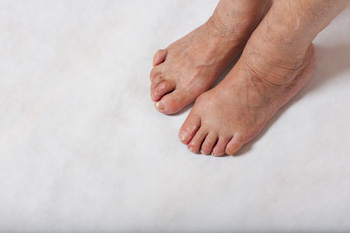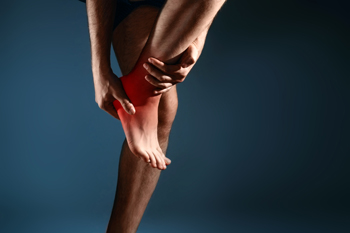
Older adults are at an increased risk of developing foot problems. If you have heel pain or pain that is located at the back of your feet, chances are that it may be one of three conditions: plantar fasciitis, bursitis, or an Achilles tendon injury. Plantar fasciitis is the most common form of heel pain. This occurs when the plantar fascia tissue on the bottom of the foot gets injured or irritated and inflamed, typically through overuse. Plantar fasciitis pain is usually more intense in the morning or after periods of rest. Your podiatrist may treat it with custom orthotics, physical therapy, corticosteroid injections, shockwave therapy, or by other means. Bursitis is an inflammatory condition that affects the bursa sac between your Achilles tendon and heel bone at the back of your foot. This is a fluid filled sac that cushions joints and bones, helps protect the tendon, and reduces friction. This bursa can become inflamed, painful, swollen, or red from repetitive motions or direct pressure. The Achilles tendon can suffer from various injuries such as ruptures, tendonitis, or enthesopathy, which are typically caused by intense or repetitive strain on the tendon. If you feel any of the symptoms described here, have a podiatrist examine you and perform whatever tests are necessary to properly diagnose your condition and devise an effective treatment plan.
Many people suffer from bouts of heel pain. For more information, contact Bruce Smit, DPM of Frankfort Foot & Ankle Clinic. Our doctor can provide the care you need to keep you pain-free and on your feet.
Causes of Heel Pain
Heel pain is often associated with plantar fasciitis. The plantar fascia is a band of tissues that extends along the bottom of the foot. A rip or tear in this ligament can cause inflammation of the tissue.
Achilles tendonitis is another cause of heel pain. Inflammation of the Achilles tendon will cause pain from fractures and muscle tearing. Lack of flexibility is also another symptom.
Heel spurs are another cause of pain. When the tissues of the plantar fascia undergo a great deal of stress, it can lead to ligament separation from the heel bone, causing heel spurs.
Why Might Heel Pain Occur?
Treatments
Heel pain should be treated as soon as possible for immediate results. Keeping your feet in a stress-free environment will help. If you suffer from Achilles tendonitis or plantar fasciitis, applying ice will reduce the swelling. Stretching before an exercise like running will help the muscles. Using all these tips will help make heel pain a condition of the past.
If you have any questions please contact our office located in Frankfort, IL . We offer the newest diagnostic and treatment technologies for all your foot and ankle needs.

Of all the afflictions that can detrimentally affect the feet, some can manipulate the toes and the way that they function. Hammertoe is one such foot condition. An individual can develop hammertoe when the second, third, or fourth toe essentially points upward at the first toe joint. This condition is called hammertoe because the affected toe begins to resemble a hammer. There are two primary types of hammertoe. First, you may develop flexible hammertoe where the affected joint can still be moved. This is arguably the less severe case of hammertoe, because it can sometimes be treated by making simple adjustments, such as being more mindful of the footwear that one chooses. Second, you may develop rigid hammertoe, which restricts the individual from moving the affected toe joint. In some cases of rigid hammertoe, the condition can only be addressed through surgery. There are a variety of surgical procedures that might be used to address rigid hammertoe. For example, a medical professional might choose to perform a tendon transfer, joint resection, or fusion. If you suspect that you might have a hammertoe, reach out to a podiatrist who will be able to diagnose and treat the problem.
Hammertoe
Hammertoes can be a painful condition to live with. For more information, contact Bruce Smit, DPM from Frankfort Foot & Ankle Clinic. Our doctor will answer any of your foot- and ankle-related questions.
Hammertoe is a foot deformity that affects the joints of the second, third, fourth, or fifth toes of your feet. It is a painful foot condition in which these toes curl and arch up, which can often lead to pain when wearing footwear.
Symptoms
Causes
Genetics – People who are genetically predisposed to hammertoe are often more susceptible
Arthritis – Because arthritis affects the joints in your toes, further deformities stemming from arthritis can occur
Trauma – Direct trauma to the toes could potentially lead to hammertoe
Ill-fitting shoes – Undue pressure on the front of the toes from ill-fitting shoes can potentially lead to the development of hammertoe
Treatment
Orthotics – Custom made inserts can be used to help relieve pressure placed on the toes and therefore relieve some of the pain associated with it
Medications – Oral medications such as anti-inflammatories or NSAIDs could be used to treat the pain and inflammation hammertoes causes. Injections of corticosteroids are also sometimes used
Surgery – In more severe cases where the hammertoes have become more rigid, foot surgery is a potential option
If you have any questions please contact our office located in Frankfort, IL . We offer the newest diagnostic and treatment technologies for all your foot and ankle needs.

Compartment syndrome is a serious condition that can affect the overall health of your foot. A group of muscles, along with nerves and blood vessels, is contained in a band of tissue called a compartment. The fascia around the muscles does not expand, so if it sustains an injury it may bleed or swell. This causes pressure to build up, which cuts off the blood supply of nutrients and oxygen to the muscle. Muscles can become permanently damaged if not treated quickly. There are two types of compartment syndrome, acute and chronic. Acute compartment syndrome is usually the result of a fracture. It also can be caused by trauma, a bruised muscle, a severe sprain, or even a cast or bandage that is too tight. Chronic compartment syndrome is caused by repetitive activity, and is more common among runners, especially those over 40. It differs from the acute syndrome because the pressure occurs only during the activity and recedes when it stops. Chronic, also called long-term, compartment syndrome can affect activity and endurance, but rarely endangers the muscles. To confirm a diagnosis of compartment syndrome, please see a podiatrist for an examination.
Foot Pain
Foot pain can be extremely painful and debilitating. If you have a foot pain, consult with Bruce Smit, DPM from Frankfort Foot & Ankle Clinic. Our doctor will assess your condition and provide you with quality foot and ankle treatment.
Causes
Foot pain is a very broad condition that could be caused by one or more ailments. The most common include:
Diagnosis
To figure out the cause of foot pain, podiatrists utilize several different methods. This can range from simple visual inspections and sensation tests to X-rays and MRI scans. Prior medical history, family medical history, and any recent physical traumatic events will all be taken into consideration for a proper diagnosis.
Treatment
Treatment depends upon the cause of the foot pain. Whether it is resting, staying off the foot, or having surgery; podiatrists have a number of treatment options available for foot pain.
If you have any questions, please feel free to contact our office located in Frankfort, IL . We offer the newest diagnostic and treatment technologies for all your foot care needs.

If you have a job that requires standing on your feet all day, you may think you just need to get used to foot pain, heel pain, swelling, blisters, back pain, sore muscles, and more. Not true! There are many things you can, and should, do to protect your feet and stay comfortable. The best thing you can do is invest in a good pair of shoes that offer proper support in your arch and heel, while giving your toes plenty of room to move. A pair of customized orthotics from a podiatrist can boost your level of comfort and support, while correcting any alignment issues that might be causing stress throughout your body. Also, take every break you are allowed to, and use the opportunity to get off your feet, while stretching and elevating them. Additionally, strengthening your foot and leg muscles through exercise will build up their endurance and help you better prepare your entire body for a long day’s work. Check with your podiatrist for further measures and foot care that will help you remain comfortable and healthy while standing at work.
While working on the feet, it is important to take the proper care of them. For more information about working on your feet, contact Bruce Smit, DPM from Frankfort Foot & Ankle Clinic. Our doctor will treat your foot and ankle needs.
Working on Your Feet
Standing on your feet for long periods of time can cause stress and pain in your feet. Your whole body may experience change in terms of posture, back pain, bunions, callouses and or plantar warts. There are ways to avoid these conditions with proper foot care, smart choices and correct posture.
Positive Changes
Negative heeled shoe – Choosing this shoe type places the heel slightly lower than the ball of the foot. These are great for overall foot health. Find shoes that fit you correctly.
Go barefoot – Our feet were not designed to be enclosed for all hours of the day. Try to periodically expose your feet to air.
Eliminate Pain
Foot Exercises – Performing simple exercises, incorporating yoga and doing stretches are beneficial. This will allow increased blood flow to the area and muscles of the foot.
Achilles tendon – Stretching the foot out flat on the floor will relax the calf muscles and tendon. These exercises can be performed almost anywhere. Make sure you add these exercises to your daily regimen.
With a little bit of this information and knowing more about foot health, you will notice changes. Foot stretches and proper footwear will help with pain and prevent further issues.
If you have any questions please feel free to contact our office located in Frankfort, IL . We offer the newest diagnostic and treatment technologies for all your foot and ankle needs.

It is very common for women who are pregnant to experience certain complications or discomfort in their feet. This is essentially because during a pregnancy, a woman’s body experiences bodily changes that oftentimes will have some sort of effect on the feet. One condition a woman might experience during her pregnancy is numbness in the feet. Sometimes referred to as a “pins-and-needles” feeling, numbness in the feet can be uncomfortable and make walking difficult. Numbness in the feet can occur during a woman’s pregnancy because as the fetus grows, the woman’s body gets increasingly swollen. This swelling at the ankles and throughout the lower legs can put pressure on nerves that can ultimately make the feet go numb. It is important to note that in addition to the feet, numbness can also affect a woman’s hands during her pregnancy. You can reduce the severity of the numbness by increasing blood flow and circulation to the lower legs and feet. If you are pregnant, or are planning to be, consider contacting a podiatrist who can offer you guidance on maintaining proper foot health throughout your pregnancy.
Pregnant women with swollen feet can be treated with a variety of different methods that are readily available. For more information about other cures for swollen feet during pregnancy, consult with Bruce Smit, DPM from Frankfort Foot & Ankle Clinic. Our doctor will attend to all of your foot and ankle needs.
What Foot Problems Can Arise During Pregnancy?
One problem that can occur is overpronation, which occurs when the arch of the foot flattens and tends to roll inward. This can cause pain and discomfort in your heels while you’re walking or even just standing up, trying to support your baby.
Another problem is edema, or swelling in the extremities. This often affects the feet during pregnancy but tends to occur in the later stages.
How Can I Keep My Feet Healthy During Pregnancy?
If you have any questions please feel free to contact our office located in Frankfort, IL . We offer the newest diagnostic and treatment technologies for all your foot and ankle needs.